Following the Path of Kahn

Built in 1972, the Kimbell Art Museum in Fort Worth, Texas, is widely regarded as architect Louis Kahn’s chef-d’oeuvre, with its minimalist interiors, muted colors, and malleable layout that allows for the permeation of natural light. Many have tried to articulate the structure’s transcendent qualities, but, as with the Acropolis, it must be experienced to be fully understood. On November 27th that experience gets bigger, with the opening of the museum’s long-awaited $135 million expansion, which sits 65 yards away from the original Kahn structure and was designed by Renzo Piano.
Well known for both building museums (the Menil Collection, the Nasher Museum of Art, the Centre Pompidou) and adding to existing ones (the Morgan Library and Museum, the Art Institute of Chicago, the High Museum of Art), Piano was an obvious choice. The five years he spent working as Kahn’s intern and apprentice in the ’60s didn’t hurt either. “Like Kahn,” says Eric M. Lee, the Kimbell’s director, “Piano creates beautifully scaled, serene galleries with masterfully orchestrated natural light in which art looks wonderful.” You’ll want to see it for yourself.
Photos: Following the Path of Kahn
Interior view of south gallery, looking out to the lawn, Renzo Piano Pavilion, September 2013 Kimbell Art Museum, Fort Worth, Texas. Photo by Robert Polidori.
Detail of concrete gallery wall, Renzo Piano Pavilion, September 2013 Kimbell Art Museum, Fort Worth, Texas. Photo by Robert Polidori.
Interior view of south gallery, Renzo Piano Pavilion, September 2013 Kimbell Art Museum, Fort Worth, Texas. Photo by Robert Polidori.
Detail of roof and beam system, Renzo Piano Pavilion, September 2013 Kimbell Art Museum, Fort Worth, Texas. Photo by Robert Polidori.
South view of the Renzo Piano Pavilion, September 2013 Kimbell Art Museum, Fort Worth, Texas. Photo by Robert Polidori.